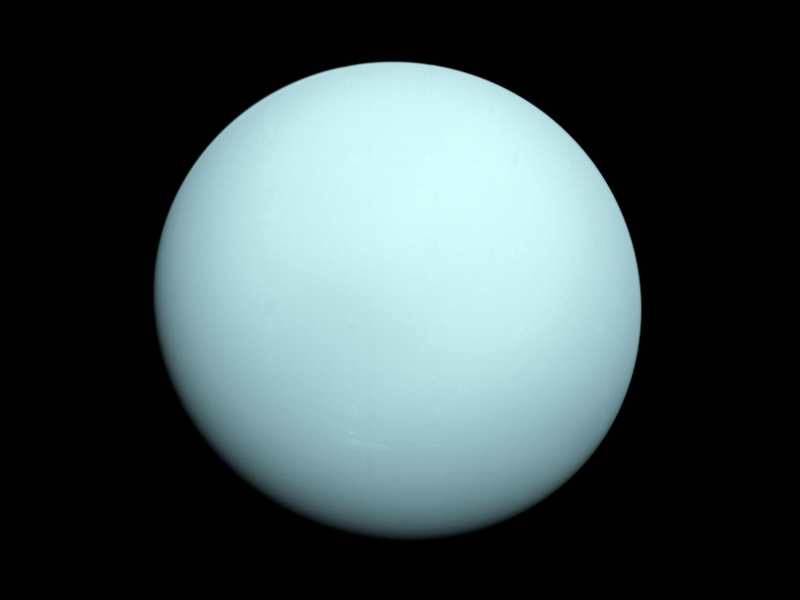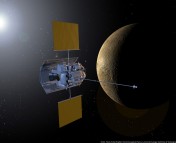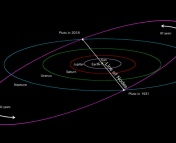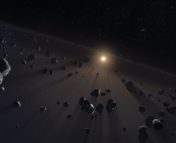Title: Did Uranus’ regular moons form via a rocky giant impactor?
Authors: Jason Man Yin Woo, Christian Reinhardt, Marco Cilibrasi, Alice Chau, Ravit Helled, Joachim Stadel
First author’s institution: Institute for Computational Science, University of Zürich, Winterthurerstrasse 190, 8057 Zürich, Switzerland
Journal: Submitted to Icarus; pre-print available on the Arxiv
Unique Uranus
For a post on 07/07, I thought it only appropriate to write a bite about the 7th planet in our solar system, Uranus. Perhaps everyone’s least favorite (or most favorite?) planet due to its name, Uranus is actually pretty cool. It’s our fourth-most massive and third largest (by radius) planet and has 27 moons! 5 of these moons—Miranda, Ariel, Umbriel, Titania, and Oberon—are “large,” while the rest are significantly smaller. Uranus even has rings, just like all the other gas and ice giants, though they are not as visible as Saturn’s, as shown in the true color image of Uranus in Fig.1. Perhaps what makes Uranus the most unique is that it’s the only planet in our solar system to have a near-90° tilt! This means it’s basically spinning on its side in comparison to all the other planets and the plane of our solar system. The cause of Uranus’ tilt is still uncertain, but today’s authors offer a hypothesis!

In addition to Uranus’ perpendicular rotation, the composition and mass distribution of its five major moons is puzzling. All of these moons are nearly 50-50 (water) ice and rock (ex. silicate), and the moons increase in mass with distance from Uranus. The masses of these moons range from one millionth to ten-thousandths the mass of Uranus with the innermost moon, Miranda, being an order of magnitude (a factor of 10) less massive than the next two moons (Ariel & Umbriel) and the final two being the most massive (Titania & Oberon). For comparison, Jupiter’s largest moons, the four Galilean moons, are all roughly the same mass. It’s been suggested since the early 90s (following the return of data from Voyager 2) that these peculiar characteristics of Uranus and its natural satellites could be explained by the impact from a large object — an otherworldly very large meteoroid, of sorts. These suggestions, however, have never fully been able to describe the system accurately. Using a variety of simulations and building upon the work of Reinhardt et al. (2020) (R20), today’s authors finally have found the specifics that best match what’s been observed.
Evolving a Proto-Uranus
They approached the problem in three parts. They first used “smoothed particle hydrodynamics” (SPH) simulations to describe the initial disc of debris created from the impact of the object. For these simulations, they assumed a three-layer structure for Uranus — a rocky core, a middle water layer, and an outer hydrogen/helium layer. The work in this paper improved upon simulations in R20 with improved and more realistic equations of state. The authors of this paper only selected the simulations from R20 that had impact-created circumplanetary discs that met certain mass requirements matching those of the current moons of Uranus. See an example of these SPH simulations in Fig. 2.

Next they used 1D disc models to evolve the disc from ice/rock soup into many little proto-moons that they call “moonlets.” These simulations required analytical solutions to the viscous disc equation, aka the equation that describes the viscosity (or fluidity) of the vapourized disc. They tracked three viscous density profiles (one for each component: H/He, ice, & rock) and two solid density profiles . They allowed these simulations to run for 10,000 years. Finally, they used N-body simulations to evolve these moonlets into the satellites we’re familiar with. Notably, they only consider moonlets outside the radius of 3.6 R_Uranus, since anything within that distance would eventually be accreted onto the planet.
The Future Studies of Uranus
After analyzing all these simulations, the authors found a simulation that best matches what we see today. They predict that the proto-Uranus was impacted by a rock 3 times the mass of the Earth at an impact velocity of 18.2 km/s (40,940 mph!) with an impact parameter of 0.75. The authors mention that although their simulations fit expectations well, they had to make some simplifying assumptions (like constant condensation temperatures and neglecting the release of latent heat during condensation) and future studies should include more detailed physics. They also suggest for us to send another space mission to Uranus to get better measurements of the composition of Uranus and its moons. Given the advances in astronomy over the past few decades, it’s amazing to think how far we still need to go in terms of uncovering the mysteries of our planetary neighbours. NASA recently approved missions to Venus, DAVINCI+ and VERITAS, and given that the last time we visited Uranus was with Voyager 2 in the late ‘80s, a new dedicated mission exploring the seventh planet from the Sun is long overdue!
Edited by: Pratik Gandhi, Luna Zagorac, Anthony Maue
Featured Image Credit: Composite Optical & X-Ray image of Uranus; X-ray: NASA/CXO/University College London/W. Dunn et al; Optical: W.M. Keck Observatory




